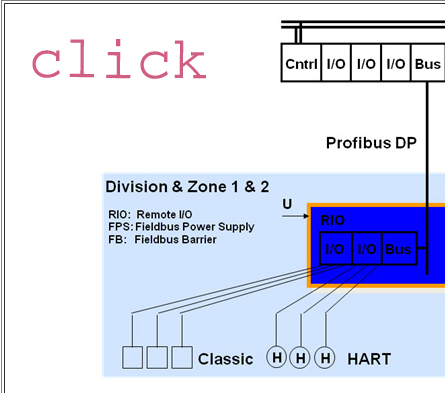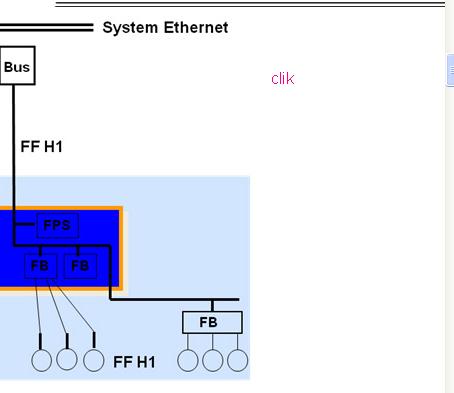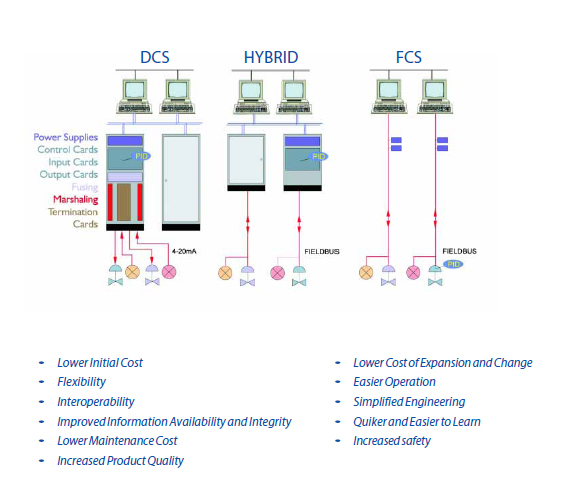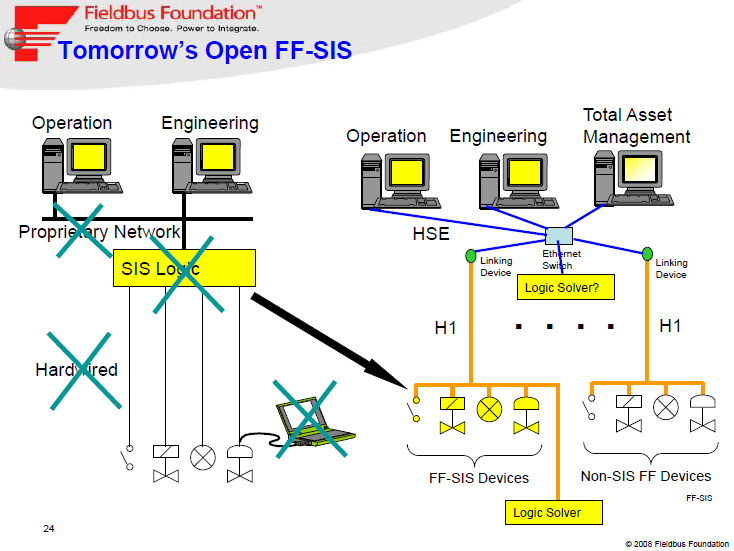Table of Contents
Background
FOUNDATION Fieldbus (FF) is a Local Area Network (LAN)
for process control sensors, actuators, and control
devices. It is a digital, two-way, multi-drop network
positioned to replace proprietary networks that connect
Programmable Logic Controllers (PLCs) of many big
companies. In traditional systems, a computer or
expensive controller unit provides control for the
network of devices. In recent years, some companies have
developed instrument systems with more intelligence
built into the devices. The main drawback of these
systems is that they are proprietary and thus not
interoperable. There are other open instrumentation
standards, such as Profibus and HART, but these
protocols do not implement control -- a separate
controller is still required. FF is an open standard
that allows the field devices to run both the
input/output and the control.Traditional systems in this market are known as 4-20 mA systems, so named for the signal levels that control the devices. These devices take input measurements and send the information to a control unit for processing. The computer then performs the necessary calculations and tells devices what their outputs should be. To get a device's serial number or to calibrate or test a device in the field, a person would have to walk (or drive) to the physical device. With FF, these types of things can be done directly from the control room. What if the computer that is running the control goes down? In a traditional system, the devices would go into some pre-defined fail-safe mode, leaving the pumps, valves, and other equipment without any interactive control until communication with the computer resumes. With FF, control is brought down to the device level. After downloading the configuration, your control loop (a PID loop, for example) continues operating even if the monitoring computer is disconnected.
|
|
4-20 mA System
|
Smart Instruments
|
FOUNDATION Fieldbus
|
| Interoperability & Interchangeability | OPEN, interoperable, interchangeable. | PROPRIETARY, limited interoperability, no interchangeability. | OPEN, interoperable, interchangeable. |
| Variety & Availability of Equipment | Wide variety. Multiple suppliers. | Limited. The customer can use only the offerings of one supplier. | Actual FF devices are limited but growing. There are, however, many ways of incorporating standard 4-20 mA devices into an FF network (using National Instruments FP-3000, for example). Multiple suppliers. |
| Communication | One variable. One direction. | Multiple variables. Two-way. | Multiple variables. Two-way. |
| Wiring | Point-to-point. | Point-to-point or multi-drop. | Multi-drop. |
Similarities
- Uses existing twisted-pair wiring
- Uses existing terminal blocks
- Similar wiring practices
- Provides for Intrinsic Safety (IS) requirements (for hazardous areas)
- Provides for power supply redundancy
-
Enables loop-powered instruments
Differences
- FF communication is digital; 4-20 mA communication is analog
- FF connects field devices in parallel; 4-20 mA connects field devices in series
- FF requires a terminator at each end (resistor and capacitor)
-
FF requires an impedance-matched power supply
Benefits
- Distributed control, meaning that control is not done by the monitoring computer. It is brought down into the devices themselves.
- Open standard, meaning that a customer can choose products from different vendors. The Fieldbus Foundation is the organization that defines the FOUNDATION Fieldbus specification and certifies products to be compliant with the standard. This guarantees that products from different vendors can be used interchangeably. The Fieldbus Foundation standardized the way the user can bring new devices into the network, set them up, and configure them. The building block in this system is the Device Description (DD). The DD tells everything about the device and its functionality. The DD lets you put an FF-certified device onto the network, import the vendor-supplied DD file into your configuration, and be ready to run. Any company with the proper resources can make an FF device (if it passes the Interoperability Test) that will work with all other FF-certified devices and software.
- The ability to use existing 4-20 mA wiring.
- Drastically reduced wiring costs. You only need one twisted wire pair that will carry multiple signals AND power, and you can drop devices off the network at any point. Since FF requires only a single set of wires to connect multiple devices, this dramatically reduces wiring costs from 4-20 mA systems, which required one pair of wires per device. Note that most, but not all devices have the option of being bus powered.
- Reduced need for controllers and other hardware.
The following figure illustrates the reduced wiring and hardware requirements. Notice that the traditional implementation requires one IS barrier and a set of wires for each device for a total of 3 barriers and 3 sets of wires. The FOUNDATION Fieldbus implementation requires only one IS barrier and one set of wires for multiple devices.

Reader Comments | Submit a comment ğ
Redundancy
Fieldbus Foundation Technology allows redundancy system.
Some Bridges support a Hot Standby Redundancy. In this
case two Bridges in the same H1 segment. Some OPC
drivers support two NIC adapters to data acquisition of
the functional Bridge (Active or Backup Bridge). These
features allow constant data acquisition during possible
Bridge maintenance and do not stop process control.
- Fauze
Renato Ardenghi, Smar. fauze@smar.com.br -
Oct 27, 2005
1 - I think is good to remember about OPC communication
driver (easy to include more supervision clients). 2 -
Some interfaces make bridge with others protocols, for
example, Modbus. This characteristic send and receive
control informations to the tradictional sistems.
- Fauze
Renato Ardenghi, Smar. fauze@smar.com.br -
Feb 17, 2004
This article is misleading and not critical in anyway
and pedals the same vendor driven line. There are
several problems with Fieldbus interoperability even the
DD & CF files on the FF website contain syntax errors
etc. Further FF is not cheaper. The actual Cabling costs
are slightly cheaper but the cost of the FF devices is
significantly more. For a possible changeout I have
evaluated it would have cost around $500,000 to adopt
FF. FF was found to be less reliable and could not be
used on the plants critical instrumentation.
- Dec 16, 2003
Legal
This tutorial (this "tutorial") was developed by
National Instruments ("NI"). Although technical
support of this tutorial may be made available
by National Instruments, the content in this
tutorial may not be completely tested and
verified, and NI does not guarantee its quality
in any way or that NI will continue to support
this content with each new revision of related
products and drivers. THIS TUTORIAL IS PROVIDED
"AS IS" WITHOUT WARRANTY OF ANY KIND AND SUBJECT
TO CERTAIN RESTRICTIONS AS MORE SPECIFICALLY SET
FORTH IN NI.COM'S TERMS OF USE (http://ni.com/legal/termsofuse/unitedstates/us/).








